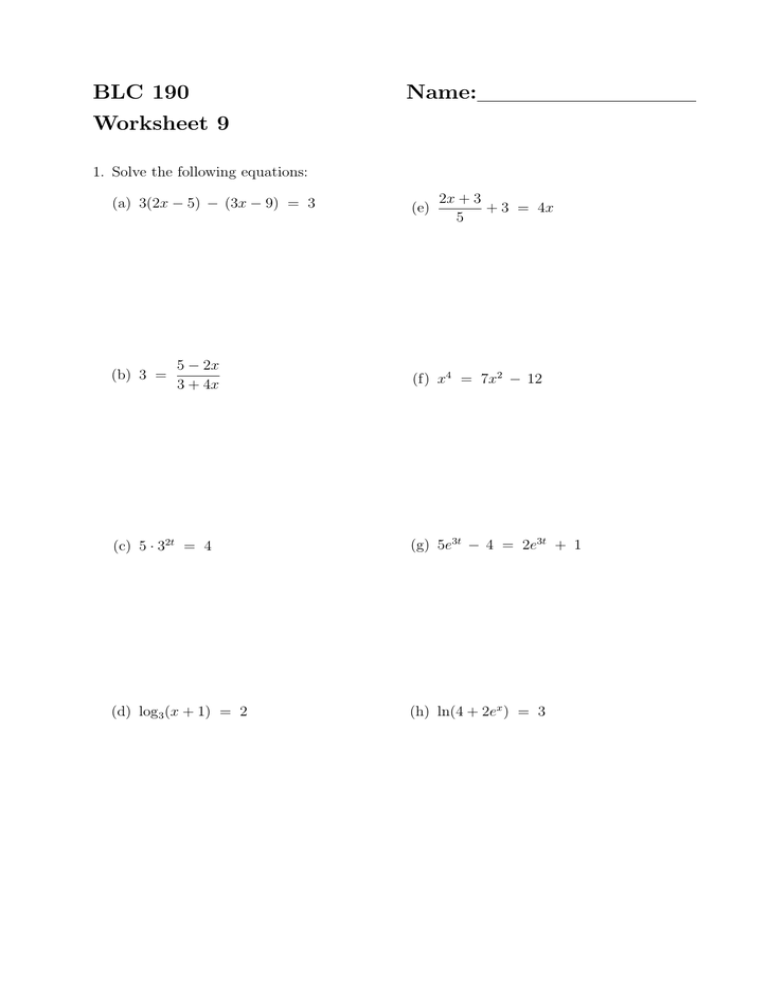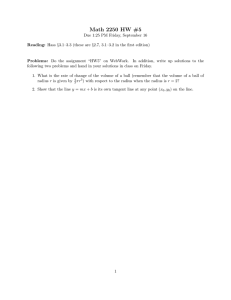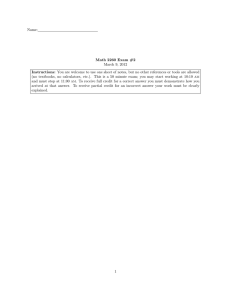BLC 190 Name: Worksheet 9 1. Solve the following equations:
advertisement

BLC 190 Name: Worksheet 9 1. Solve the following equations: (a) 3(2x − 5) − (3x − 9) = 3 (b) 3 = 5 − 2x 3 + 4x (e) 2x + 3 + 3 = 4x 5 (f) x4 = 7x2 − 12 (c) 5 · 32t = 4 (g) 5e3t − 4 = 2e3t + 1 (d) log3 (x + 1) = 2 (h) ln(4 + 2ex ) = 3 2. Solve the following equation for y: 3xy − 2x = 5y + 7x + 3 3. Solve the following equation for y: ey 1 + 2ey x = 4. Solve the following equation: 3 5 − =0 x+2 x−3 2 5. Rationalize the denominator of the following fractions: (a) √ 3 x−5 (b) √ x+4 √ x+ y 6. Suppose that f (x) = sin(x2 ) and g(x) = ex . (a) What is f (g(x))? (b) What is g(f (x))? 3 7. Find all solutions to the following equations. Give the exact answers in radians. (a) 3 csc θ + 7 = 1 (b) cos θ + sin θ = 0 (c) sec2 θ − 3 sec θ + 2 = 0 4 8. A meteorologist is using a weather balloon to measure the air temperature at high altitudes. At the time of the measurement, the air temperature at sea level was approximately 24◦ C, and the air temperature at an altitude of 4.0 km was approximately −3◦ C. Assume that the air temperature is linearly related to altitude. (a) Find a linear formula for the air temperature at an altitude of x kilometers. (b) What is the air temperature at an altitude of 2.3 km? (c) At what altitude will the air temperature be −13◦ ? 5 9. At noon a bacteria culture contains 200 bacteria. Five hours later, the culture contains 3000 bacteria. Assume that the number of bacteria continues growing exponentially at the same rate. (a) Find a formula for the number of bacteria after t hours. (b) How many bacteria will there be at 7:45 pm? (c) At what time will there be 5 million bacteria? e.g. 12:37am.) 6 (Give your answer as a time, 10. A heavy metal ball is placed into a tin can, and then liquid is added until the top of the ball is just barely covered: cylindrical can 6 in. liquid ball 2 in. The can is a cylinder 6 inches high, with a radius of 2 inches, and the ball is a sphere of radius R. (a) Find a formula for the volume of liquid in the can as a function of R. (Hint: The volume of a cylinder with height h and radius r is V = πr2 h, and the volume of a sphere with radius r is V = 43 πr3 .) (b) Sketch a graph of the volume of the liquid as a function of R (from (a)). 25 20 15 10 5 ! ! 0.5 " r (inches) 7 1.5 2




